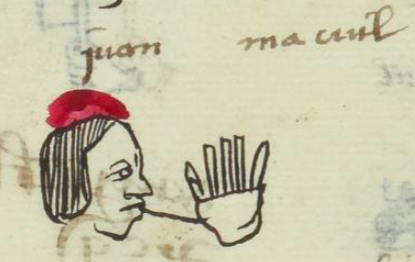Macuil (MH525v)
This black-line drawing of the compound glyph for the personal name Macuil shows a hand (maitl) with five (macuilli) rectangular fingers of the type sometimes used in notations. We are classifying this glyph as a logogram for the number five, but we also recognize that the ma- start to the word for five comes from the hand (maitl), making it both logographic and phonographic.
Stephanie Wood
The abbreviation for macuilli (five) for the name Macuil is not unusual. Chicome will be seen abbreviated as Chicon, too. And see below for examples of counters that take the shape of both thin rectangles and dots.
Macuil is probably all that remains of a calendrical name that involved the number five in combination with any one of twenty day signs, such as xochitl, or the like. This would be a name given to the man as a child, depending upon the day in the 260-day divinatory calendar (tonalpohualli) that coincided with his birth. By the time of this manuscript, 1560, evolution was taking place in the use of the divinatory calendar, whereby either the number was dropping away, or in this case, the day sign was lost or omitted consciously. Macuil is an especially prevalent example of this change.
Something else worthy of tracking is the use of macuil- in place of chico- as a root for the number five. For instance, chicome is chic- (five) plus ome (two), resulting in "seven."
Stephanie Wood
juan macuil
Juan Macuil
Stephanie Wood
1560
hands, manos, fingers, dedos, números, cinco, tonalpohualli, calendarios, días, fechas, dates

macuil(li), five, https://nahuatl.wired-humanities.org/content/macuilli
ma(itl), hand, arm, https://nahuatl.wired-humanities.org/content/maitl
Matrícula de Huexotzinco, folio 525v, World Digital Library, https://www.loc.gov/resource/gdcwdl.wdl_15282/?sp=130&st=image.
This manuscript is hosted by the Library of Congress and the World Digital Library; used here with the Creative Commons, “Attribution-NonCommercial-ShareAlike 3.0 License” (CC-BY-NC-SAq 3.0).







